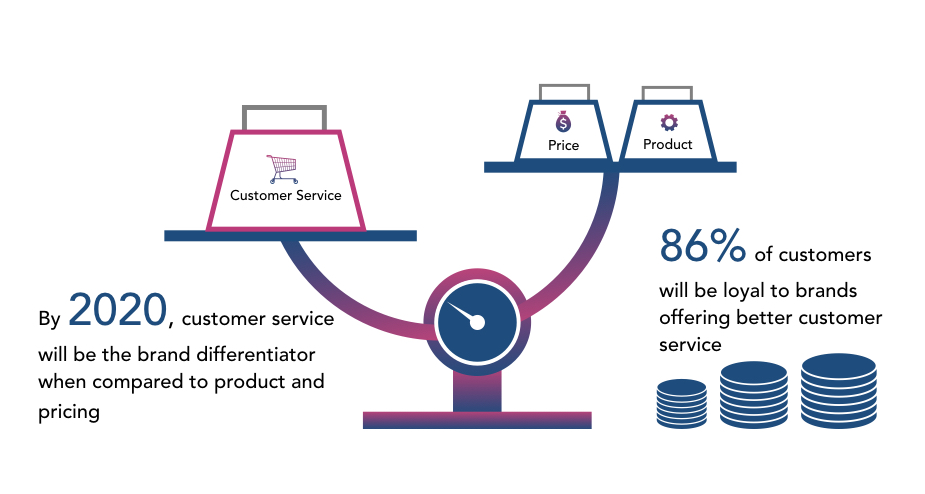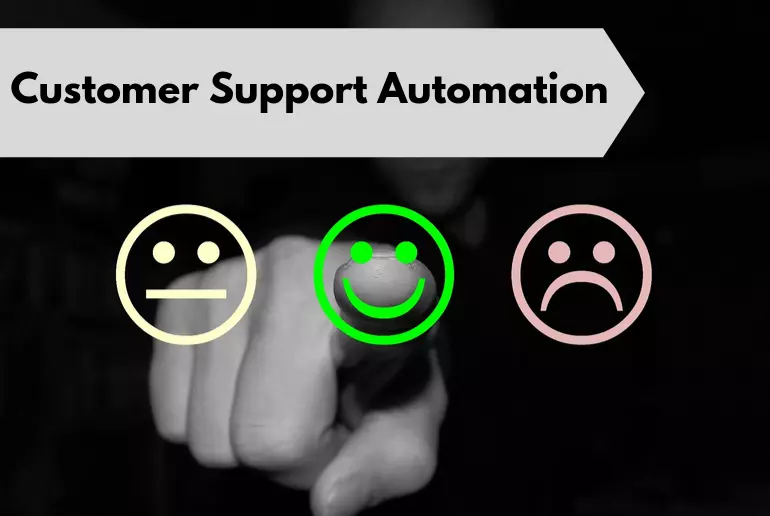What comes into your mind when you hear about customer service? It may be a pleasant exchange with the customer support agent, a frustrating session, or a brand. From surveys, we can understand the hard reality. Here is a snapshot:
“80% of companies say they deliver “superior” customer service. When the same question is asked from customers, only 8% of people think these same companies are delivering.” – Bain & Company.
These days, “brand experience” matters a lot. Stats and market studies show that it is one of the difficult factors driving brand loyalty. Of course, it has the upper hand in pricing, brand awareness, and product legacy. I want to share a couple of quick fact checks here:

“More than two-thirds of marketers say their companies compete mostly based on customer service.” – Gartner.
How can brands live up to the expectation?
Buyers or prospects are always expecting a seamless customer support experience. As we discussed, nowadays it is playing a crucial part as well. From a buyer’s point of view, it is not about spending money. It is all about making it worthwhile. For that, they are expecting continuous and uninterrupted support.
Automation is pivotal in providing exceptional support services in this AI era. Let’s take a deep dive into it.
What is Customer service automation?
It is a form of customer support without human intervention. It would be the best fit solution to answer the following:
- Recurring straightforward questions (FAQs)
- Status update and tracking
- How to do steps (Process related queries)
- Troubleshooting
- Queries related to product catalog
Customers expect to find answers within a click of a button and a blink of an eye. Hence we can experience a significant rise in the adoption rate. After engaging with us, our customers from the travel and e-commerce industry reduced 70% of the support team’s overhead.
Role of chatbot in customer service automation
“What is the best fit solution for customer service automation?” This is a common question that we are hearing from prospective customers. Most of them turned into customers, in any case 🙂
A conversational interface, specifically a chatbot, would be the best fit solution. A chatbot is AI software that can trigger automated interaction with your customers. It can start a conversation based on an event, contextual trigger, or pre-defined condition checks.
The chatbot can seamlessly offer the following services:
- Can be proactive or reactive
- Consistent responses and immediate responses
- An effective way to collect data and learn from it
- Integration with different mediums like messaging platforms, live chat, social media platforms & CRMs
- Interaction with any 3rd party software using API integration.
There are two types of chatbots- Guided flow-based and Conversational-based. A brand can choose one based on the use cases and audience.
Guided flow chatbots:
- It will help the customers to get the results within definite steps
- The bot will provide options to select for different operations
- It will guide the users to achieve their goals
- A best-fit solution to handle self-help operations and common queries
Conversational chatbots:
- These chatbots will understand the context of the conversation and guide users
- Powered by Natural Language Processing engines
- Best fit for enterprise solutions, lead generation process, quick product check.
We always prefer a combination of two for our customers. Sometimes a user will like to get into a particular step straight away. Then the guided flow won’t be a good option.
According to the survey conducted by Audience, MyClever, Salesforce, and Drift, customers are facing some issues while using online support channels. Here is a sneak peek of the inferences:

Let’s take the first five pain points into account. It shows the importance of chatbots and a live-interaction mechanism.
- Sites are hard to navigate.
- Can’t get answers to simple questions
- Basic details about a business are hard to find
It takes too long to find services - Poorly designed smartphone apps
In the use-case section, we can see how a chatbot can complement these pain points.
Customer service chatbot use-cases
Tracking & order management

Aftersales Chatbot
Incorporate self-help chatbots for your online eCommerce stores for a better customer experience.
For online companies, customer support operations will juice up the running cost. About 65% to 70% of the user queries are straightforward and process-related. Self-help bots can guide users through the step-by-step process. It could handle the following operations with ease:
- Order tracking and status
- Order cancellation
- Order modification
- My orders management
- Get invoices
- Refund initiation
Our goal-based analytics feature will enable you to track the chatbot’s performance. You can gain insights into individual customer support agent performance, department performance, drop-off rates, employee satisfaction, etc.
Check company and product details
Here the chatbot will act as a digital agent. For online or eCommerce businesses, customers can have a quick chat with the bot and place an order. It would be the best use-case to integrate with WhatsApp. No website navigation is required to select a specific product in mind.
Bots could reduce the cart abandonment rate by contacting customers through FB messenger, WhatsApp, and mobile apps. It could start the conversation like, “Hey, the product has been in the cart for a month. We have a 10% discount now”.
Bots could reduce the cart abandonment rate by contacting customers through FB messenger, WhatsApp, and mobile apps. It could start the conversation like, “Hey, the product has been in the cart for a month. We have a 10% discount now”.
- Questions related to services or products
- Pricing information
- Demo scheduling
- Handling support tickets and walk-through steps.
- Troubleshooting steps

Chatbot Sales-person
Deploy chatbots as your sales personnel who are compassionate to your customers.
FAQ automation

FAQ Chatbot
Aftersales customer support through patient FAQ chatbots
Clarifying a user’s queries or customers within a blink of an eye is the key. If your brand has only a live chat or email and phone line support system, customers don’t like to wait till the start of your business hours to get answers. Most of them will research the brands/ solutions after their office hours. Chances of losing interest are high if they wait till the next day.
So a 24/7 x 365 touchpoint is a must to meet their needs. Conversational chatbots are very much relevant to this situation. They can learn from your FAQ base and answer by understanding the context. WhatsApp integration will give you a perfect mechanism to establish a constant touch. How, What, Why, When, Who questions can get handled without human intervention.
We provide a content management system powered by NLP to train the chatbot. The bot will learn from the unanswered questions using our semi-automated learning process. Also, a FAQ section to equip the bot with the knowledge base.
Feedback collection and survey using chatbot
Feedback collection is an elixir of customer service. Surveys and feedback will bridge the gap between the brand and customer expectations. Survey emails and forms are getting outdated day by day. Giants in advertising mediums are searching for new interfaces. A chatbot will help brands to collect feedback in a non-intrusive way. The chatbot can make use of the following:
- Net promoter score
- Like or dislike
- Star ratings
- Text input and voice input-based feedback
A conversational interface to conduct a survey is the new trend these days. It will drive the users to give inputs rather than fill out a form. FB messenger bot, WhatsApp bot, and conversational webpages are the best platforms to integrate.

Survey Chatbot
Conduct non-invasive surveys on your customers to understand what matters to them.
Customer onboarding

Customer Registration Chatbot
With state of the art computer vision models, onboard your new customers just by uploading their ID card
Chatbots can replace the tiring form filling and telephonic conversation with onboard customers. A bot can collect an id card and extract information. Using the NLP engine’s support, the bot can also understand the meaning of the content. We integrate cognitive document parsing to collect data from users—no need to fill in the forms or get in a call with the support team.
E.g., a Bot can get the name, address, gender, and id number from an id card. By integrating facial recognition, the bot will provide verification support as well.
Payment due date and renewal check
You have a bunch of customers for your product. Also, the expiry date is approaching for most of them. How are you going to communicate with them?
Please don’t think of a manual mode of engagement. You can leverage the broadcast feature of our chatbot to automate the reach-out activity. It will be effective by integrating the bot with WhatsApp and Facebook messenger.

Handle Complaints
Deploy your friend 24×7 to look out for potential negativity from your customers
Complaint management Bot
AI chatbots could automate complaint and dispute management over chat. Brands can focus on the follow-up and nurturing part rather than handling complaints.
The bot will collect personal information, user account details, images, and documents about the complaint. Finally, it can process the refund or product exchange. Or, the customer can opt for interaction with support agents using our in-built escalation mechanism.

Finance Support Bots
Automate payment collection and reminder activities through chatbots.
Benefits of automated customer service in brand experience POV
- 24/7 * 365 support: Give round-the-clock and uninterrupted service for 365 days. Stretching your customer support beyond business hours will earn brand loyalty—a cost-effective way to retain customers.
- Quick fact check and support: The chatbot could quickly serve users who want answers to direct questions for process and policy-related queries. This will aid the customer’s buying decision as well. Nobody would like to wait in a queue and unattended.
- Pick from where they left: Our platform will keep the transcript of the bot-user interactions. The chatbot is capable enough to trace out the returned customers. It could restart the conversation by inferring from where they left. Trust and care will nurture exceptional customer service.
- Multi-channel support: Increase your brand touchpoints by deploying the chatbots on multiple platforms depending on your business category. Integrating chatbots with messaging platforms will increase exposure to customers. Integration with third-party applications will expand the scope of automation. E.g., Ticket management software, CRM, ERP.
- Instant feedback collection: A feedback collection mechanism powered by analytics will enable us to understand customer emotions. Emotion analytics will provide insights to improve branding strategies and deliverable quality.
- Target millennials: Millennials are the next significant buying power. Surveys and studies show that they are reluctant to do phone calls. They prefer texting more. Botify your business and gain more.
Are you planning to create a customer service chatbot for your brand?
Before proceeding, I would like to make a clear statement. All customers are not fit for automation. Some of them fall into the following categories:
- Irate customers: Those who are using complex words and statements while chatting. Their emotional state will be anger. Any automation failure makes them angrier.
- High-touch customers: Those with several queries are eager to have a detailed conversation. They might be on the verge of making a decision. Maybe they will make the bot stumped. A human touch will always be good for closing deals.
- New customers: Applicable for SaaS and PaaS enterprises. They might need detailed support if they ask questions outside of the “help” context.
How can we solve this? – A hybrid model
Create a chatbot with our chatbot builder tool – CreyoFace, to enable the hybrid model. Live chat transfer is possible based on the context of a conversation. You can fine-tune our NLP engine to understand the context as you need.
While registering with us will also gain access to our live-agent support portal. Also, your team can spectate bot-user conversations as well. If you find something is deviating, you could intervene and take control.
Ready To Explore?
Frequently Asked Questions?
What is a customer service chatbot?
Chatbots can provide businesses with a more efficient, cost-effective, and personalized way of interacting with customers, improving customer satisfaction, and ultimately benefiting your brand.
Can chatbots replace human customer service representatives?
While chatbots can handle many routine and repetitive inquiries, they are not entirely meant to replace human representatives. There are complex issues that may require human empathy, judgment, or personalization. Chatbots are best used in conjunction with human support to provide an enhanced customer experience.
How secure is the information shared with customer service chatbots?
Customer service chatbots can be designed with security measures to protect customer information. It is crucial to implement data encryption and access controls and follow best practices to ensure the security and privacy of customer data.
Can customer service chatbots be integrated with other systems or platforms?
Yes, customer service chatbots can be integrated with various systems or platforms, such as customer relationship management (CRM) tools, ticketing systems, knowledge bases, or e-commerce platforms. The integration enables chatbots to access relevant information and provide more personalized support.
How can customer chatbots maintain a conversational tone and engage customers effectively?
Chatbots can be programmed to use conversational language and tone, incorporating elements like greetings, empathy, and appropriate responses to create a more engaging and human-like interaction.
How does a customer service chatbot work?
Customer service chatbots typically use natural language processing (NLP) to understand and interpret customer messages. They analyze the input, identify the customer’s intent, and generate appropriate responses based on predefined rules, machine learning models, or a combination of both.
Are customer service chatbots capable of understanding different languages?
Yes, many customer service chatbots can be designed to understand and respond in multiple languages. Language support depends on the capabilities and configurations of the specific chatbot implementation.
What happens if a customer service chatbot cannot answer a question?
If a chatbot cannot provide a satisfactory answer, it can escalate the query to a human representative. This allows complex or specific issues to be addressed by a person with the necessary expertise.
Can customer service chatbots handle multiple customer inquiries simultaneously?
Yes, one of the key advantages of customer service chatbots is their ability to handle multiple conversations simultaneously, providing efficient support to multiple customers at once.
Are chatbots able to understand and respond to customer emotions?
Some chatbots are equipped with sentiment analysis capabilities, allowing them to identify customer emotions and respond accordingly with empathy or appropriate actions.








